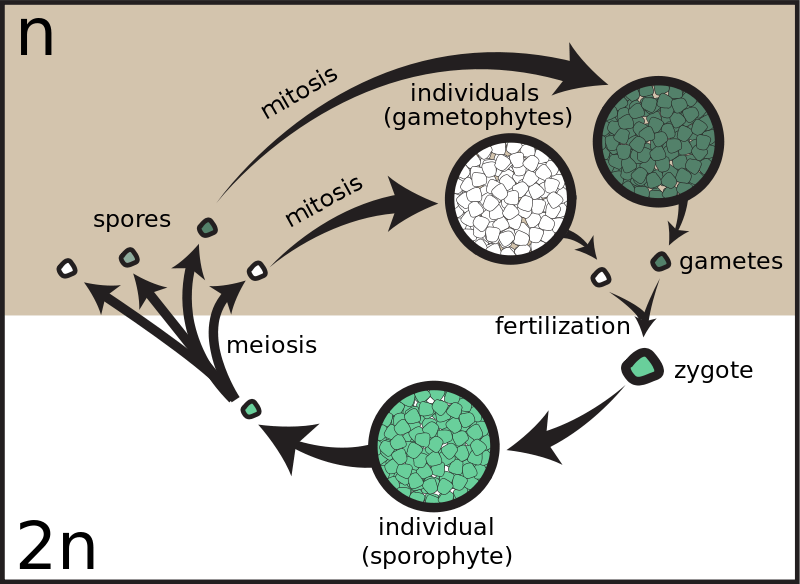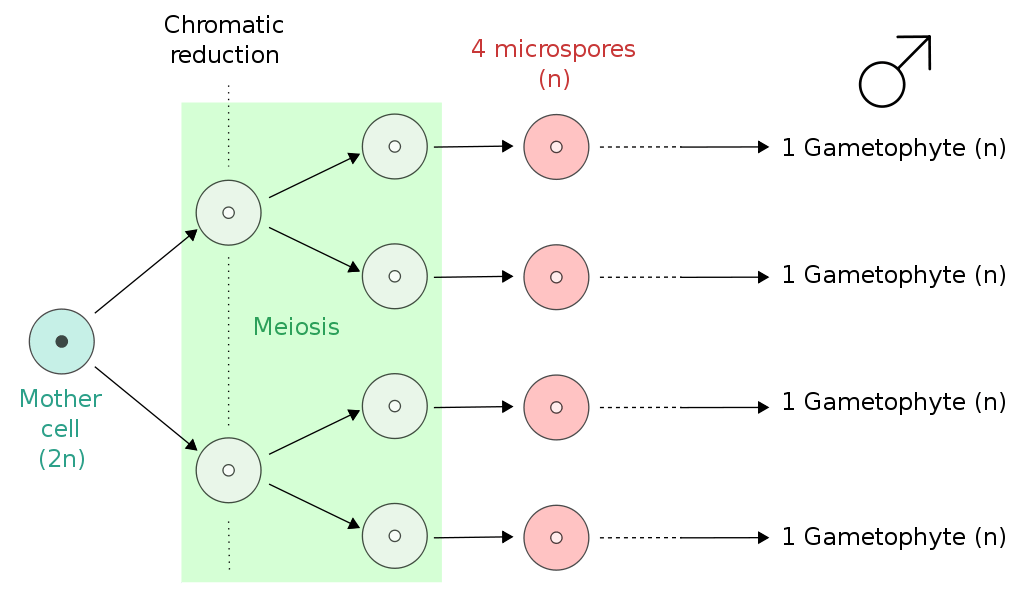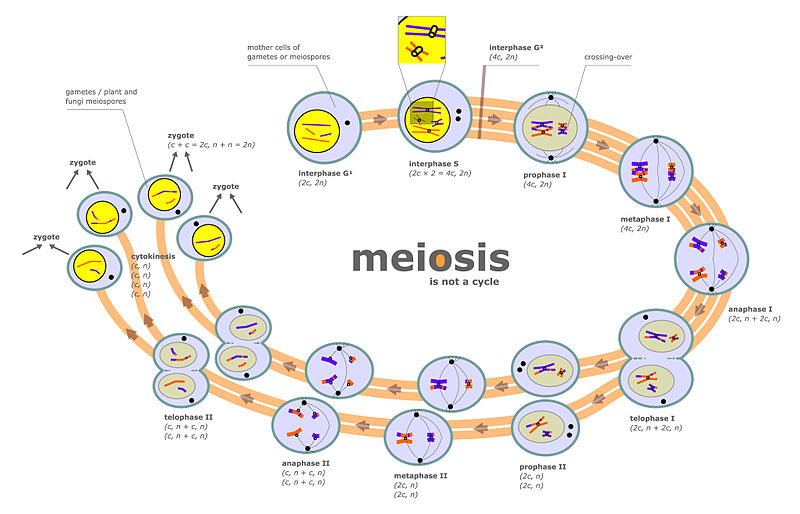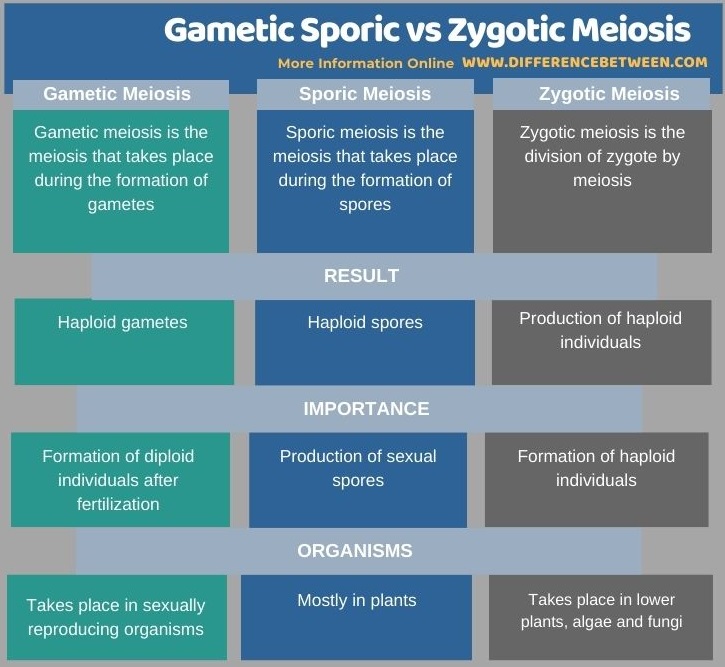Difference Between Gametic Sporic and Zygotic Meiosis
Table of Contents
The key difference between gametic sporic and zygotic meiosis is that gametic meiosis is the meiosis that occurs during the formation of male and female gametes while sporic meiosis is the meiosis that occurs during the sporogenesis and zygotic meiosis is the meiosis that occurs in the zygote.
Most life cycles include both haploid and diploid stages. In order to return from the diploid stage to the haploid stage, meiosis is the key. Meiosis is one of the two types of cell divisions. Diploid cells divide by meiosis and produce haploid cells which contain only one set of chromosomes. From one cell, four daughter cells are produced by meiosis. Most importantly, during meiosis, genetic recombination takes place. Hence, the daughter cells are genetically different from the parent cell. Genetic recombination is an important evolutionary process. Meiosis occurs via two consecutive meiosis processes: meiosis I and meiosis II. During the life cycle of an organism, meiosis takes place in order to produce gametes, spores and also for zygote division.
CONTENTS
1. Overview and Key Difference
2. What is Gametic Meiosis
3. What is Sporic Meiosis
4. What is Zygotic Meiosis
5. Similarities Between Gametic Sporic and Zygotic Meiosis
6. Side by Side Comparison – Gametic vs Sporic vs Zygotic Meiosis in Tabular Form
7. Summary
What is Gametic Meiosis?
Gametes are the male and female sexual cells of organisms. They are haploid cells containing only one set of chromosomes. Female gametes carry half of the mother chromosomes while male gametes carry half of the father’s chromosomes. They fuse with each other in order to make a diploid zygote. Therefore, meiosis should take place to make haploid cells from diploid cells. Meiosis will make sure that gametes receive only one set chromosomes. The meiosis which takes place during the formation of the gametes is known as gametic meiosis.

Figure 01: Gametic Meiosis
What is Sporic Meiosis?
Sporic meiosis is the meiotic cell division that takes place during sporogenesis. Sporogenesis refers to the process which produces spores. Generally, plants, algae and fungi produce spores in order to reproduce. Hence, sporogenesis is a stage during their life cycle. When they form spores, meiotic cell division takes place. Sporic meiosis is an important event in sexual reproduction and helps to complete their life cycle. In some organisms, sporogenesis is accompanied by mitosis when producing asexual spores. In some organisms, both meiotic and mitotic sporogenesis are required to complete their complex life cycle.

Figure 02: Sporic Meiosis
In sporic meiosis, a diploid spore mother cell, which resides within the sporangium, undergoes meiosis. It results in four haploid spores. In heterosporous organisms, two types of spores are produced via sporic meiosis: microspores and megaspores. In flowering plants, microspores are produced in the anthers of flowers. In conifers, sporic meiosis takes place in microsrobili and megastrobili when producing microspores and megaspores.
What is Zygotic Meiosis?
Zygote is a diploid cell formed from the fusion of two opposite sex cells. In certain organisms such as cellular slime moulds and dinoflagellates, the zygote undergoes meiosis to produce haploid individuals. Hence, zygotic meiosis refers to the division of zygote by meiosis to produce haploid cells which form haploid individuals. In simple words, zygotic meiosis is the type of cell division which forms haploid cells from a zygote. In these organisms, especially in fungi and green algae, the multicellular stage is haploid. Hence, once the diploid zygote is formed, it should undergo meiosis to produce haploid spores. Then, those haploid spores divide by mitosis in order to produce multicellular haploid individuals.

Figure 03: Meiosis
What are the Similarities Between Gametic Sporic and Zygotic Meiosis?
- All three types of meiosis produce haploid cells.
- They are very important processes in order to complete their life cycles.
What is the Difference Between Gametic Sporic and Zygotic Meiosis?
Gametic meiosis takes place when the gametes are formed while sporic meiosis takes place when the spores are formed for sexual reproduction. Meanwhile, in zygotic meiosis, the zygote undergoes meiosis. So, this is the key difference between gametic sporic and zygotic meiosis. Gametic meiosis is important in order to produce a diploid cell after fertilization and then a multicellular diploid organism. Sporic meiosis is important in order to produce haploid sexual spores for sexual reproduction mainly in plants. Zygotic meiosis is important for the formation of multicellular haploid individuals such as fungi and green algae. Thus, this is the functional difference between gametic sporic and zygotic meiosis.
Below is a summary tabulation of the differences between gametic sporic and zygotic meiosis for side by side comparison.

Summary – Gametic Sporic vs Zygotic Meiosis
Every species has a unique number of chromosomes in their genome. These chromosomes carry the genetic information of the individual. In order to maintain the consistency of the number of chromosomes in generations, meiosis takes place. Because of meiosis, cells receive half of the total chromosomes. Meiosis helps sexual reproduction. Moreover, meiosis helps to produce haploid individuals. Depending on the stage at which meiosis takes place, it can be catetgorized as gametic, sporic and zygotic meiosis. Gametic meiosis takes place during the gamete formation while sporic meiosis takes place during the sporogenesis and zygotic meiosis takes place during the haploid cell formation. Thus, this summarizes the difference between gametic sporic and zygotic meiosis.
Reference:
“Sporogenesis.” Wikipedia, Wikimedia Foundation, 25 Dec. 2019, Available here.
“14.5: Life Cycles.” Biology LibreTexts, Libretexts, 16 July 2020, Available here.
Image Courtesy:
1. “Sporic meiosis” By Sporic meiosis.png: Original uploader was Menchi at en.wikipedia.Derivative work: Rehua (talk) – This file was derived from: Sporic meiosis.png: (CC BY-SA 3.0) via Commons Wikimedia
2. “Microspore-formation” By Emmanuel Boutet – Own work (CC BY-SA 3.0) via Commons Wikimedia
3. “Meiosis diagram” By Marek Kultys – Own work (CC BY-SA 3.0) via Commons Wikimedia
ncG1vNJzZmivp6x7pbXFn5yrnZ6YsqOx07CcnqZemLyue8OinZ%2Bdopq7pLGMm5ytr5Wau26zwKacraGTYsCxu9GimmaZnpl6u8XGqKuim12isqq70qKqaA%3D%3D